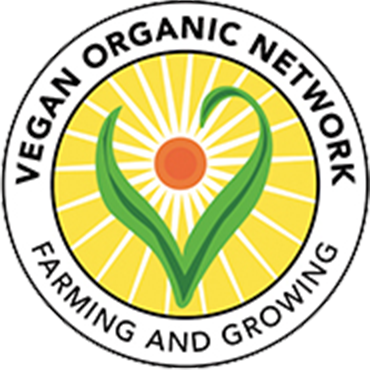About us
Why grow veganic?


For people, animals and the planet
Thousands of farmers and growers across the globe are showcasing how stockfree organic farms and veganic food production offers solutions to many pressing issues. “Veganic” is a combination of the two words “vegan” and “organic” to create a new concept for farming. World agriculture must move towards “people nourished per hectare”.
This is where large scale stockfree organic agriculture proves itself to use less land, water and fossil fuel resources than livestock dependent systems. Simultaneously it also causes less harmful greenhouse gas emissions and polluting wastes. Veganically produced food is resilient to the largest problems facing humanity, namely peak oil, availability of fertile land and climate instability. In 2005 the Vegan Organic Network (VON) produced the world’s first set of Stockfree Organic Standards to be certified by inspection.
Farmer lain Tolhurst (Tolly) explains his reason for becoming certified: “We have never kept livestock, and as organic growers we began to seriously question the wisdom of importing fertility back in the early nineties. We banned the use of fish, blood and bone on our farm in the light of the BSE crisis. To this day slaughterhouse byproducts can still be used in potting mixes for organically approved seed raising.” (eg John Innes formulas)
Slaughterhouse byproducts and manures are two sides of the same industry
Most consumers assume that organic production relies on animal manures to support fertility.
- Bringing manure in from another farm is depriving that farm of its own fertility.
- The transport of bulky manures is expensive.
- Nonorganic manures may contain antibiotics and wormer residues.
- All manures under 5 months old pose an E.Coli risk.
- Nonorganic manures are a byproduct of livestock systems that depend on imported feedstuffs like genetically modified soya. Even organic livestock farmers rarely are closed loop as they by in feed etc. There is a direct link with deforestation in the Amazon and the feeds livestock, horses and pets eat in the UK. Many vegetable, fruit and grain farmers do not have livestock, so to improve their resilience they need to develop fertility systems that are towards closedloop and nonreliant on the livestock industry.
Tolly continues: “We worked closely with VON to establish the Stockfree Organic Standards in 2005 and were the first farm in the world to become registered as such. The Standards were set up for those wanting high quality, locally available and organically grown food without the use of slaughterhouse byproducts or animal manures.” Farmers and growers can become certified stockfree organic by formal inspection by an organic certifying body, such as the Soil Association in the UK.
Farming and climate
Change without borders

Belching our way to climate chaos
Grazed and Confused
Meta analysis by the Food Climate Research Network has shown the potential of grazing livestock to contribute to soil carbon sequestration is small, time limited, reversible and outweighed by the GHG they generate. Ruminants (cows and sheep) contribute 80% of total livestock emissions, and even with careful grazing management the report found that this would only offset between 20-50% of annual emissions of ruminants.

Principles for climate friendly food
- reduce the second population explosion (human’s being the first population explosion) of livestock through a moratorium on breeding to stop the associative environmental problems highlighted in Livestock’s Long Shadow;
- move away from industrial inputs including HaberBosch nitrogen, artificial chemicals and genetically modified organisms;
- move towards “people nourished per hectare” on arable land where starchy vegetables and grains (for direct human consumption) become the majority of farmed arable land. Market gardens and allotments will then provide the micronutrients of more perishable fruit and vegetables;
- move towards soil conservation practices on arable land including reintroducing flowering green manuring leys to reverse “insectageddon” (decline of insects);
- return society’s organic wastes to market gardens / allotments;
- move towards “people nourished per hectare” on some marginal land with an emphasis on fruit bushes, orchards, nut groves and forest gardening. The vast majority of marginal land will be for other uses including forestry, managed conservation (e.g. rewetting peat bogs) and rewildling, all of which will help with flood prevention caused by bare hillsides;
- and move towards renewable energy for farming and a localised food system where practicable. The Veganic approach offers a viable, holistic and accessible way of ensuring that present and future generations can live safely and comfortably, as well as eat abundantly, healthily and harmoniously within the earth’s finite limits.
Soil care

Composting

Stay in touch
For any enquiries relating to membership (or changes of address if you’re a member) please contact the membership secretary at membership@veganorganic.net – see also our Join Us page for more info.
Otherwise please get in touch with the Vegan Organic Network for any queries you have about vegan organic growing, or for more info about how to get involved.
